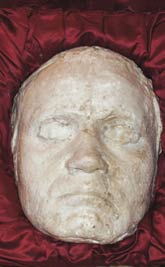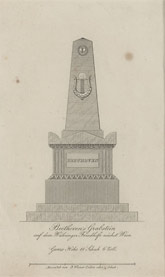1800 - 1830
Beginning and precursors
Any architectural or plastic monument displayed in public to honour an outstanding person can serve as a
monument.
Therefore, the Beethoven bust which Franz Klein produced in 1812 can be seen as a monument itself because
Beethoven's friend, Andreas Streicher, ordered this bust and intended to display it in a hall of his piano
manufacture along with other portraits of admired musicians. The room served as a concert hall, so the public
had access to the bust. Although the sculpture is quite modest and its main function is just to portray the
composer, it can already be regarded as the first Beethoven monument.
The aspect of veneration becomes much more visible when taking a look at Beethoven's tomb which some friends of
the composer had put up on the Währing cemetery.
The tomb resembles a group of tombs erected at the end of the 18th and early 19th century for which monumental
architectural elements were used to honour the deceased in an elevated way and enhance their importance.
Obelisks were especially popular for these middle class tombs.
Soon, these memorials lost their original purpose and tombs became middle class monuments which could be put up almost anywhere. An early example for such a genuine monument for a member of the middle classes is the obelisk erected for Johann Georg Büsch, a grammar school teacher from Hamburg. The similarity of such monuments to Beethoven's tomb gives evidence that people in Vienna followed these ideas and that Beethoven's tombstone marks the border between evocative memorial and monument.




